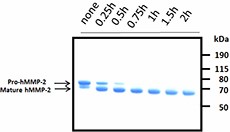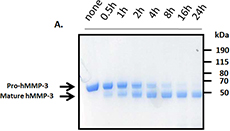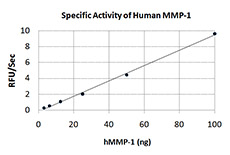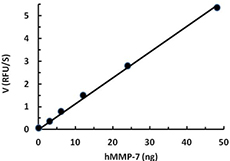- Regulatory Status
- RUO
- Other Names
- Matrix metallopeptidase 2, Gelatinase A, MMP2, GelA, Clg4a
- Ave. Rating
- Submit a Review
- Product Citations
- 1 publications

| Cat # | Size | Price | Quantity Check Availability | Save | ||
|---|---|---|---|---|---|---|
| 554308 | 500 µg | 2808€ | ||||
| 554302 | 10 µg | 179€ | ||||
| 554304 | 25 µg | 352€ | ||||
| 554306 | 100 µg | 934€ | ||||
MMP-2, also named gelatinase A, is a member of matrix metalloproteinase family proteins (MMPs). MMPs are structurally related, zinc-containing enzymes that degrade the extracellular matrix and connective tissue proteins in normal physiological processes such as embryonic development, reproduction, and tissue remodeling as well as in disease processes such as arthritis and metastasis. MMP-2 consists of a prodomain, which is cleaved upon activation, a catalytic domain containing the zinc binding site, a fibronectin-like domain (that plays a role in the substrate targeting), and a carboxyl-terminal (hemopexin-like repeats) domain. Activation of MMP-2 requires proteolytic processing: first, a complex of membrane type 1 MMP (MT1-MMP) and tissue inhibitor of metalloproteinase 2 recruits pro-MMP-2 from the extracellular milieu to the cell surface; second, MMP-2 is activated by active MT1-MMP and subsequent autocatalytic cleavage. Substrates of MMP-2 include type IV collagen, aggrecan, link protein, decorin, fibronectin, and type X and XI collagens, all of which are components of the articular cartilaginous matrix. Importantly, MMP-2 secretion is elevated in several types of human cancers and its elevated expression has been associated with a poor prognosis. Mutations in the MMP-2 gene are associated with Torg-Winchester syndrome, multicentric osteolysis, arthritis syndrome, and possibly keloids. MMP-2 deficient mice exhibit slightly delayed growth, reduced neovascularization, retarded tumor progression, an exaggerated asthma response to allergens, and impaired branching morphogenesis of the mammary gland.
Product DetailsProduct Details
- Source
- Human MMP-2, amino acids (Ala30-Cys660) (Accession# NP_004521.1) with a C-terminal His tag and a linker sequence, was expressed in 293E cells.
- Molecular Mass
- This 652 amino acid recombinant protein has a predicted molecular mass of approximately 73.2 kD. The protein migrates at about 73 kD in DTT-reducing conditions and about 73 kD in non-reducing conditions by SDS-PAGE.The predicted N-terminal amino acid is Ala.
- Purity
- >95%, as determined by Coomassie stained SDS-PAGE.
- Formulation
- 0.22 µm filtered protein solution is in TCN (25 mM TRIS, 5 mM CaCl2, 150 mM NaCl, pH 7.5).
- Endotoxin Level
- Less than 1.0 EU per µg of protein as determine by the LAL method
- Concentration
- 10 and 25 µg sizes are bottled at 200 µg/mL. 100 µg size and larger sizes are lot-specific and bottled at the concentration indicated on the vial. To obtain lot-specific concentration and expiration, please enter the lot number in our Certificate of Analysis online tool.
- Storage & Handling
- Unopened vial can be stored at -20°C or -70°C for six months. For maximum results, quick spin vial prior to opening. Avoid repeated freeze/thaw cycles.
- Activity
- Human MMP-2 cleaves the modified fluorogenic peptide Mca-PLGL-Dpa-AR-NH2 with an activity above 1100 pmol/min/µg.
- Application
-
Bioassay
- Application Notes
-
Human MMP-2 at a concentration 100 µg/mL was activated for at least 1 h at 37°C in the presence of 1 mM APMA to produce activated MMP-2. The final assay condition was 10 ng of activated MMP-2 and 10 µM of substrate. Reaction was read at excitation and emission of 320 nm and 405 nm, respectively, in kinetic mode for 5 min.
This protein is in the latent form and needs to be activated for bioassay.
BioLegend carrier-free recombinant proteins provided in liquid format are shipped on blue-ice. Our comparison testing data indicates that when handled and stored as recommended, the liquid format has equal or better stability and shelf-life compared to commercially available lyophilized proteins after reconstitution. Our liquid proteins are verified in-house to maintain activity after shipping on blue ice and are backed by our 100% satisfaction guarantee. If you have any concerns, contact us at tech@biolegend.com. - Product Citations
-
Antigen Details
- Structure
- Monomer
- Distribution
-
MMP-2 is expressed by fibroblasts, endothelial cells, alveolar epithelial cells, and macrophages.
- Function
- Degradation of ECM and connective tissue proteins, angiogenesis, tissue remodeling, cancer metastasis and MMP-2 secretion is elevated in several types of cancers.
- Ligand/Receptor
- TIMPs, CCL7, thrombospondin 1.
- Bioactivity
- Human MMP-2 cleaves the peptide substrate Mca-PLGL-Dpa-AR-NH2.
- Biology Area
- Angiogenesis, Cell Adhesion, Cell Biology, Neuroinflammation, Neuroscience, Stem Cells
- Molecular Family
- Enzymes and Regulators
- Antigen References
-
1. Nagase H, and Woessner JF. 1999. J. Biol. Chem. 274:21491.
2. Martignetti JA, et al. 2001. Nat. Genet. 28:261.
3. Itoh T, et al. 1997. J. Biol. Chem. 272:22389.
4. Passlick B, et al. 2000. Clin. Cancer. Res. 6:3944.
5. Qian Q, et al. 2010. Cancer Invest. 28:661.
6. Hoikkala S, et al. 2006. Cancer Lett. 236:125.
7. Yamamura T, et al. 2002. Cancer. 35:249. - Gene ID
- 4313 View all products for this Gene ID
- UniProt
- View information about MMP-2 on UniProt.org
Related FAQs
- Why choose BioLegend recombinant proteins?
-
• Each lot of product is quality-tested for bioactivity as indicated on the data sheet.
• Greater than 95% Purity or higher, tested on every lot of product.
• 100% Satisfaction Guarantee for quality performance, stability, and consistency.
• Ready-to-use liquid format saves time and reduces challenges associated with reconstitution.
• Bulk and customization available. Contact us.
• Learn more about our Recombinant Proteins. - How does the activity of your recombinant proteins compare to competitors?
-
We quality control each and every lot of recombinant protein. Not only do we check its bioactivity, but we also compare it against other commercially available recombinant proteins. We make sure each recombinant protein’s activity is at least as good as or better than the competition’s. In order to provide you with the best possible product, we ensure that our testing process is rigorous and thorough. If you’re curious and eager to make the switch to BioLegend recombinants, contact your sales representative today!
- What is the specific activity or ED50 of my recombinant protein?
-
The specific activity range of the protein is indicated on the product datasheets. Because the exact activity values on a per unit basis can largely fluctuate depending on a number of factors, including the nature of the assay, cell density, age of cells/passage number, culture media used, and end user technique, the specific activity is best defined as a range and we guarantee the specific activity of all our lots will be within the range indicated on the datasheet. Please note this only applies to recombinants labeled for use in bioassays. ELISA standard recombinant proteins are not recommended for bioassay usage as they are not tested for these applications.
- Have your recombinants been tested for stability?
-
Our testing shows that the recombinant proteins are able to withstand room temperature for a week without losing activity. In addition the recombinant proteins were also found to withstand four cycles of freeze and thaw without losing activity.
- Does specific activity of a recombinant protein vary between lots?
-
Specific activity will vary for each lot and for the type of experiment that is done to validate it, but all passed lots will have activity within the established ED50 range for the product and we guarantee that our products will have lot-to-lot consistency. Please conduct an experiment-specific validation to find the optimal ED50 for your system.
- How do you convert activity as an ED50 in ng/ml to a specific activity in Units/mg?
-
Use formula Specific activity (Units/mg) = 10^6/ ED50 (ng/mL)


 Login / Register
Login / Register 




















Follow Us